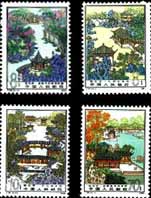
The garden of CHINA
 | The garden of CHINA |
Zhuozhengyuan (Humble Administrator's Garden), located inside the Loumen Gate in Suzhou, Jiangsu Province, is one of the four great gardens of Suzhou. Suzhou is a city with beautiful scenery, and the hometown of many outstanding personalities. Suzhou houses gardens of China's masterpieces. Zhouzhengyuan was originally the residence of Lu Guimeng, a poet of the Tang Dynasty and became Dahong Temple in the Yuan Dynasty. During the Zhengde period of the Ming Dynasty, Administrator Wang Xianchen resigned from his post and returned to his hometown. He bought the temple and rebuilt it into his residence. The name "Zhouzhengyuan" had its source from "On Idle Stay at Home", a prose by Pan Yue who was a prose writer of the Jin Dynasty. He wrote "Tending a garden and selling vegetables grown in it is the politics of a plain man." Following the Confucius tradition, scholars and government officials in ancient China would take active part in social life under favorable conditions and retire and live in solitude in countryside when things turned against them.
Design: The set includes four stamps, depicting some of the famous scenes of Zhuozhengyuan. Gardens in Suzhou are ingenious combinations of natural landscapes and artificial scenes, with very elegant and exquisite rocks and ponds everywhere. The Hall of Distant Fragrance Shown on the stamp is the main hall of the garden. In the hall, one can see the surrounding scenes through its long windows. In front of the hall, there stands a slightly undulating rock while in the north there is a pavilion by the pond. The pond is divided by two mounds which look like two islands. On the hill covered with trees and flowers, there are the pavilion of Fragrant Snow and Azure Clouds and the Pavilion of Expecting Frost. People can go up there to get a view of the surrounding area and take a little break. The Pipa Courtyard is located east of the Hall of Distant Fragrance. Through an arch gate, one enters into a little yard where there is the House of Exquisiteness. Standing at the arch gate, one gets unique views of the Jiashi Pavilion in the south and of the Pavilion of Fragrant Snow and Azure Clouds in the north.
The designer is ingenious as regards to the composition of the stamp. The garden has a total area of 60 mu and two fifths of it is covered by water. All the buildings actually stand by water. Water links all the pavilions, houses and halls, rockeries, bridges, winding corridors, trees and flowers on the stamp. They look scattered around but with regularity and necessary space between them.
 Homepage Homepage |  Email Email |